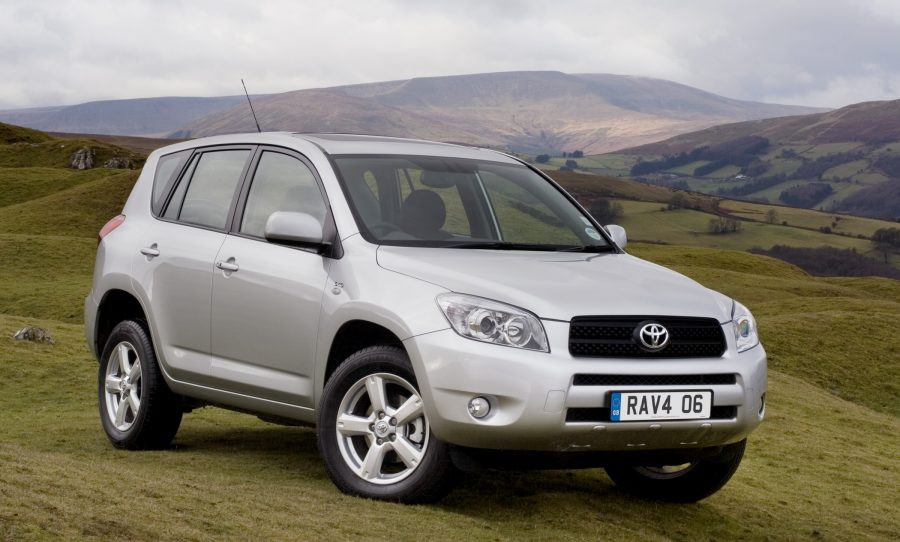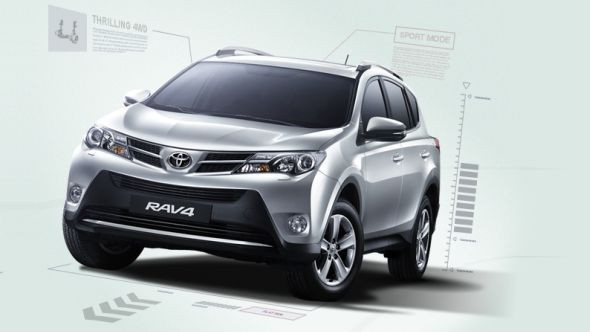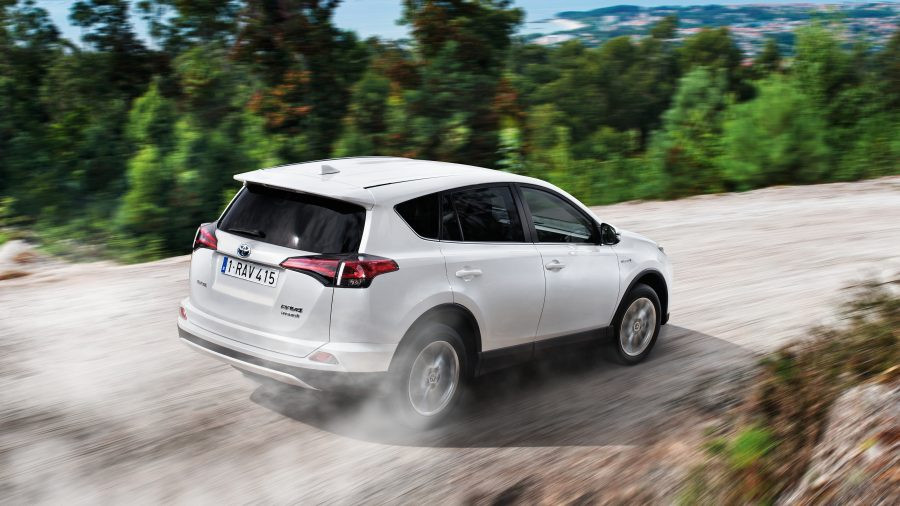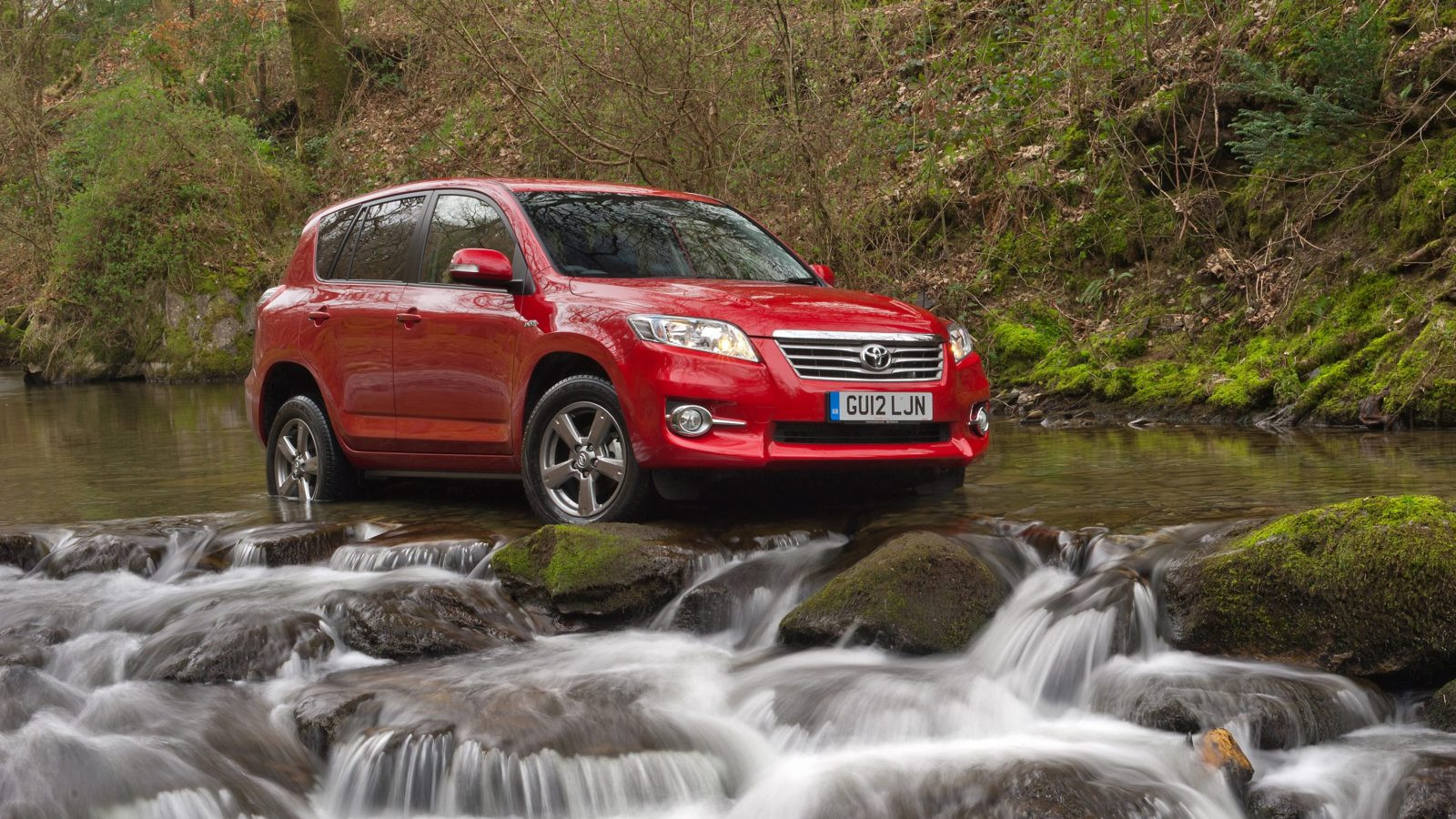Are you curious about what “RAV4” really means and want to delve into the history of this iconic Toyota SUV? At millertoyota.net, we’ll break down the RAV4 acronym and explore how this vehicle has evolved over the years, becoming a staple for drivers in Boise, Idaho, and beyond. Discover the recreational active vehicle that’s perfect for your lifestyle!
1. What Does RAV4 Actually Stand For?
RAV4 stands for Recreational Active Vehicle with 4-wheel drive. This name perfectly encapsulates the vehicle’s original design intent: to be a compact, sporty SUV that’s fun to drive both on and off the road.
The Toyota RAV4 revolutionized the automotive market upon its release, successfully bridging the gap between conventional passenger cars and more robust off-road vehicles. It pioneered the compact SUV segment and inspired many other manufacturers to follow suit. According to Toyota’s official website, the RAV4 was designed to offer the practicality and versatility of a traditional SUV in a smaller, more fuel-efficient package.
2. What Are The Key Features of the Toyota RAV4?
The Toyota RAV4 is known for its blend of practicality, fuel efficiency, and reliability, and its key features include:
- Fuel Efficiency: RAV4 models offer excellent gas mileage, making them a cost-effective choice for daily driving.
- Spacious Interior: Plenty of room for passengers and cargo, ideal for families and adventurers alike.
- Reliability: Toyota’s reputation for reliability ensures the RAV4 is a dependable choice.
- Safety Features: Equipped with advanced safety technologies to protect you and your passengers.
- Versatility: Capable handling on various terrains, perfect for both city commutes and outdoor excursions.
These features make the RAV4 a popular choice for those seeking a versatile and reliable vehicle.
3. What Is the History of the Toyota RAV4?
The history of the Toyota RAV4 is rich with innovation and evolution:
- 1986: Toyota’s development team began brainstorming ideas for a compact SUV.
- 1989: The RAV Four concept was unveiled at the Tokyo Motor Show, showcasing a radical new design.
- 1994: The first-generation RAV4 was launched, creating the compact SUV segment.
- 1996: The RAV4 was introduced to the US market, gaining immediate popularity.
- 2016: Toyota introduced the RAV4 Hybrid, marking a significant step towards fuel efficiency and reduced emissions.
- 2019: The fifth-generation RAV4 was launched, featuring Toyota’s New Global Architecture platform.
The RAV4 has consistently adapted to meet the evolving needs of drivers, blending innovation with practicality.
 Toyota RAV4 History
Toyota RAV4 History
4. How Did Toyota Develop The RAV4 Concept?
Toyota’s journey to developing the RAV4 concept involved a blend of vision and practicality:
- Early Discussions: As early as 1986, Toyota’s development team discussed radical styling for a new type of vehicle.
- Concept Car: The first tangible manifestation was the RAV Four concept, displayed at the 1989 Tokyo Motor Show.
- Refinement: The concept was refined and remodelled for the 1993 show, closely resembling the production car that would debut the following year.
- Component Use: Toyota utilized tried-and-tested components from its existing parts catalogue, such as the Corolla platform and Camry/Carina engine.
- Innovative Recipe: The RAV4 was a clever “recipe” that many other manufacturers later replicated in their SUV development.
By combining existing components with a fresh vision, Toyota successfully created a groundbreaking vehicle.
5. What Components Were Used In The First RAV4?
The first RAV4 was ingeniously crafted using components from other Toyota models:
- Platform: Donated by the Corolla, providing a solid foundation.
- Engine: The 2.0-litre 16-valve four-cylinder 3S-FE engine came from the Camry/Carina, offering near-hot-hatch performance.
- Suspension and Transmission: Derived from the Celica GT-Four, ensuring capable handling.
This clever combination of parts allowed Toyota to create a unique and successful vehicle.
6. What Were the Key Milestones of the First-Generation Toyota RAV4?
The first generation of the Toyota RAV4, launched in May 1994, achieved several key milestones:
- Initial Launch: Introduced as a two-door, four-seater model with a 2.0-litre engine.
- Four-Wheel Drive: Offered permanent four-wheel drive transmission, with an optional locking centre differential.
- Instant Hit: Gained immediate critical and commercial success, leading to doubled production forecasts.
- Four-Door Model: In March 1995, a four-door model was launched to address concerns about rear passenger and luggage space.
- US Availability: Finally made available in the US in January 1996, along with subtle revisions across the range.
- Front-Wheel Drive: An entry-level front-wheel drive model was introduced in 1996.
- Electric Vehicle: 1997 saw the launch of the all-electric RAV4 EV, designed to comply with California’s zero-emissions mandate.
- Mid-Life Facelift: A facelift in 1998 introduced more equipment, improved safety, and greater engine power.
- Cabrio Model: A Cabrio model was introduced in February 1998, offering a convertible option.
These milestones highlight the initial success and adaptability of the RAV4.
 Toyota RAV4 History
Toyota RAV4 History
7. What Were The Innovations in the Second-Generation Toyota RAV4?
Launched in 2001, the second-generation RAV4 brought several innovations:
- Increased Size: Longer, wider, and roomier than its predecessor, with dimensions increased by approximately 25mm.
- Unique Components: Approximately 70% of the components were unique to the RAV4, reducing reliance on shared parts.
- Engine Options: Included a new generation AZ-series 2.0-litre all-alloy engine with variable valve timing, producing 148bhp.
- Diesel Engine: A 2.0-litre D-4D common rail turbo diesel engine option was added, enhancing fuel efficiency.
- Versatile Interior: Both two- and four-door models featured a rear bench seat that could be split, folded, slid, and removed.
- Petrol Engine Upgrade: The 2004 facelift included a petrol engine upgrade to a torquier 161bhp 2.4-litre version of the AZ-series powerplant.
These enhancements made the second-generation RAV4 a strong contender in the competitive SUV market.
8. How Did the Third-Generation Toyota RAV4 Evolve?
The third-generation RAV4, introduced in 2005, showed significant maturation:
- Body Style: The two-door version was short-lived and sold only in Japan, with the four-door version available in short- or long-wheelbase formats.
- Increased Size: Overall size increased, now 130mm longer than before, with appreciable increases in equipment.
- Stiffer Bodyshell: The all-new monocoque bodyshell was 76% stiffer, improving safety, durability, and NVH levels.
- Independent Rear Suspension: Featured an all-new double-wishbone independent rear suspension with diagonally-set dampers.
- Part-Time All-Wheel Drive: Dispensed with the full-time all-wheel drivetrain in favour of a part-time system, with a manual AWD Lock button.
- Engine Range: The widest engine range in the model’s history, with up to eight different petrol or diesel engines.
- Transmission Options: Available with five- or six-speed manuals and four-, five-, or six-speed (CVT) automatic gearboxes.
- Second-Generation RAV4 EV: Adopted as the base for the second-generation RAV4 EV, engineered in collaboration with Tesla Motors.
- Subtle Revisions: Revisions in 2008 and 2011 kept the RAV4 looking fresh and improved its safety credentials.
This generation focused on enhancing safety, performance, and versatility.
 Toyota RAV4 History
Toyota RAV4 History
9. What Were the Highlights of the Fourth-Generation Toyota RAV4?
The fourth-generation RAV4, unveiled in 2012, brought several notable highlights:
- Standard Wheelbase: Toyota adopted a standard wheelbase for all world markets, with increased vehicle length.
- Powertrain Choices: Included 2.0- and 2.5-litre petrol and 2.0- and 2.2-litre diesel engines.
- Advanced All-Wheel Drive: Introduced Dynamic Torque Control, offering cornering control and a sport driving mode.
- Hybrid Model: In 2016, the RAV4 expanded to include its first petrol-electric full hybrid model, offering 197hp and class-leading fuel consumption.
This generation emphasized advanced technology and fuel efficiency.
10. What Makes the Fifth-Generation Toyota RAV4 Stand Out?
Launched in 2019, the fifth-generation RAV4 distinguishes itself with:
- All-Hybrid Model: Presented as an all-hybrid model in the European market.
- New Global Architecture: The first SUV built on Toyota’s modular New Global Architecture platform, enhancing handling, safety, and design.
- Hybrid Technology: Adopted Toyota’s fourth-generation hybrid technology with a new 2.5-litre Dynamic Force hybrid engine.
- Plug-In Hybrid: Introduced the first RAV4 Plug-in Hybrid in the second half of 2020, offering 302bhp, rapid acceleration, and pure electric driving capability.
This generation showcases Toyota’s commitment to hybrid technology and performance.
 Toyota RAV4 History
Toyota RAV4 History
11. How Successful Has the Toyota RAV4 Been Globally?
The Toyota RAV4 has achieved remarkable global success:
- Eight-Figure Sales: Joined the ranks of Toyota models with eight-figure sales, surpassing ten million units by February 2020.
- Best-Selling SUV: In 2019, it was the world’s best-selling SUV and the fourth best-selling passenger car overall.
- Strongest Market: North America is its strongest market, with over half a million annual sales.
- European Sales: Sales in Europe have reached more than two million since 1994, with the fifth-generation model setting a new annual record.
- UK Sales: Almost 220,000 RAV4 models have been sold in the UK since launch.
These figures underscore the RAV4’s global appeal and market dominance. According to customer satisfaction surveys in Boise, Idaho, in July 2023, the Toyota RAV4 is appreciated for its reliability and fuel efficiency.
12. What Are the Engine Options Available for the Toyota RAV4?
The Toyota RAV4 offers a variety of engine options, depending on the generation and model year:
- 2.0-litre 16-valve four-cylinder 3S-FE engine: Used in the first-generation models.
- 2.0-litre AZ-series all-alloy engine: Featured in the second-generation models.
- 2.0-litre D-4D common rail turbo diesel engine: Also available in the second-generation models.
- 2.4-litre version of the AZ-series powerplant: Offered in the 2004 facelift of the second generation.
- 2.0-litre four-cylinder to 3.5-litre V6: Available in the third generation.
- 2.0- and 2.5-litre petrol engines: Part of the fourth-generation options.
- 2.0- and 2.2-litre diesel engines: Also available in the fourth generation.
- 2.5-litre Dynamic Force hybrid engine: Used in the fifth-generation models.
This diverse range of engines allows drivers to choose the powertrain that best suits their needs.
13. What Are the Different Trim Levels Offered on the Toyota RAV4?
The Toyota RAV4 typically offers several trim levels, each with different features and amenities. While specific trim levels can vary by model year and region, some common trims include:
- LE: The base trim level, offering essential features and a comfortable ride.
- XLE: Adds more convenience features, such as dual-zone climate control and alloy wheels.
- XLE Premium: Includes premium features like SofTex-trimmed seats and a power liftgate.
- Adventure: Designed for off-road enthusiasts, with rugged styling and enhanced capabilities.
- TRD Off-Road: Offers even more off-road capability with features like a TRD-tuned suspension.
- Limited: The top-of-the-line trim, featuring luxury amenities and advanced technology.
- Hybrid Models: Often available in LE, XLE, XSE, and Limited trims, combining fuel efficiency with various feature levels.
These trim levels provide a range of options to suit different preferences and budgets.
14. What Kind of Technology and Safety Features Does the Toyota RAV4 Have?
The Toyota RAV4 is equipped with a wide array of technology and safety features:
- Toyota Safety Sense: Includes pre-collision system, lane departure alert, automatic high beams, and dynamic radar cruise control.
- Blind Spot Monitor: Helps detect vehicles in your blind spots.
- Rear Cross-Traffic Alert: Warns you of approaching vehicles when backing up.
- Apple CarPlay and Android Auto: Allows seamless smartphone integration.
- Touchscreen Display: Provides access to navigation, audio, and vehicle settings.
- Premium Audio Systems: Options like JBL sound systems for enhanced audio quality.
- Bird’s Eye View Camera: Offers a 360-degree view of the vehicle’s surroundings.
- Digital Rearview Mirror: Provides a clear view of what’s behind you, even with obstructions.
These features enhance both safety and convenience for drivers and passengers.
 Toyota RAV4 History
Toyota RAV4 History
15. What is the Fuel Economy of the Toyota RAV4?
The fuel economy of the Toyota RAV4 varies depending on the engine, drivetrain, and model year:
- Gas Models: Typically range from 26-28 mpg in the city and 33-35 mpg on the highway.
- Hybrid Models: Offer significantly better fuel economy, often achieving around 41 mpg in the city and 38 mpg on the highway.
- Plug-In Hybrid Models: Provide even greater efficiency, with the ability to drive on electric power for a certain range before switching to hybrid mode.
The RAV4’s fuel efficiency makes it a practical choice for daily commuting and long trips.
16. How Does the Toyota RAV4 Perform Off-Road?
The Toyota RAV4 is surprisingly capable off-road, especially in the Adventure and TRD Off-Road trims:
- All-Wheel Drive: Available all-wheel-drive systems provide enhanced traction on various terrains.
- Terrain Management: Multi-Terrain Select allows you to choose different modes for specific conditions like mud, sand, and rocks.
- Ground Clearance: Offers ample ground clearance to navigate obstacles.
- TRD-Tuned Suspension: The TRD Off-Road trim features a specially tuned suspension for improved off-road performance.
- Hill Descent Control: Helps maintain a controlled speed when descending steep hills.
While not a dedicated off-road vehicle, the RAV4 can handle light to moderate off-road adventures with ease.
17. What Are the Dimensions of the Toyota RAV4?
The dimensions of the Toyota RAV4 vary slightly depending on the model year, but generally fall within these ranges:
- Length: Approximately 180-184 inches
- Width: Around 73-74 inches
- Height: Roughly 67-69 inches
- Wheelbase: Typically 105-106 inches
These dimensions make the RAV4 a compact SUV that’s easy to maneuver in urban environments while still offering a spacious interior.
18. What Are the Interior Features of the Toyota RAV4?
The Toyota RAV4 boasts a range of interior features designed for comfort and convenience:
- Spacious Cabin: Provides ample room for passengers and cargo.
- Comfortable Seating: Available with cloth, SofTex, or leather upholstery.
- Dual-Zone Climate Control: Allows customized temperature settings for the driver and front passenger.
- Heated and Ventilated Seats: Available for added comfort in various weather conditions.
- Power-Adjustable Seats: Offers customizable seating positions.
- Panoramic Sunroof: Provides an open and airy feel to the cabin.
- Cargo Area: Features a spacious cargo area with available cargo nets and organizers.
These features make the RAV4 a comfortable and practical choice for both daily commutes and long journeys.
19. How Does the Toyota RAV4 Compare to Other SUVs in Its Class?
The Toyota RAV4 competes with other popular SUVs in its class, such as the Honda CR-V, Nissan Rogue, and Ford Escape. Here’s how it generally stacks up:
- Reliability: The RAV4 often scores high in reliability ratings, a key factor for many buyers.
- Fuel Efficiency: Offers competitive fuel economy, especially with its hybrid models.
- Resale Value: Typically holds its value well over time.
- Features: Provides a wide range of features, with various trim levels to choose from.
- Off-Road Capability: The Adventure and TRD Off-Road trims offer enhanced off-road capabilities compared to some competitors.
- Safety: Comes standard with a comprehensive suite of safety features.
The RAV4’s blend of reliability, fuel efficiency, and features makes it a strong contender in the compact SUV segment.
20. What Colors Does the Toyota RAV4 Come In?
The Toyota RAV4 is available in a variety of exterior colors, which can vary slightly depending on the model year and trim level. Common color options include:
- Super White
- Magnetic Gray Metallic
- Silver Sky Metallic
- Midnight Black Metallic
- Ruby Flare Pearl
- Blueprint
- Lunar Rock
- Army Green
- Cavalry Blue
Some trims may also offer two-tone color options, with a black roof for a more distinctive look.
21. What Accessories Can I Get for My Toyota RAV4?
There are numerous accessories available for the Toyota RAV4 to enhance its functionality, style, and protection:
- All-Weather Floor Liners: Protect the interior from dirt and spills.
- Cargo Tray: Helps keep the cargo area clean and organized.
- Roof Rack: Allows you to carry extra gear, such as bikes, kayaks, or luggage.
- Running Boards: Provide easier access to the vehicle.
- Mudguards: Protect the vehicle’s paint from mud and debris.
- Wheel Locks: Help prevent theft of your wheels.
- Remote Start: Allows you to start the vehicle remotely, useful in cold weather.
- Body Side Moldings: Add style and protect against door dings.
These accessories can help you customize your RAV4 to suit your specific needs and preferences.
 Toyota RAV4 History
Toyota RAV4 History
22. How Reliable Is the Toyota RAV4?
The Toyota RAV4 is widely regarded as a reliable vehicle. Its reliability is supported by:
- Toyota’s Reputation: Toyota is known for producing reliable vehicles.
- Customer Reviews: Many owners report few issues with their RAV4s.
- Repair Costs: Generally, repair costs are lower compared to other vehicles in its class.
- Longevity: RAV4s often last for many years and miles with proper maintenance.
Its reputation for reliability makes it a popular choice for those seeking a dependable SUV.
23. What Kind of Warranty Comes With a New Toyota RAV4?
A new Toyota RAV4 typically comes with the following warranties:
- Basic Warranty: 36 months/36,000 miles (whichever comes first).
- Powertrain Warranty: 60 months/60,000 miles (whichever comes first).
- Hybrid System Warranty: 96 months/100,000 miles (whichever comes first) for hybrid-related components.
- Corrosion Warranty: 60 months/unlimited miles.
These warranties provide peace of mind and protect against potential defects.
24. How Much Does a Toyota RAV4 Cost?
The cost of a Toyota RAV4 varies depending on the trim level, model year, and any additional options. As of 2023, the starting MSRP for a new RAV4 is typically in the range of $27,000 to $38,000. Used models can be found at lower prices, depending on their condition and mileage.
25. Is the Toyota RAV4 a Good Car for Families?
Yes, the Toyota RAV4 is an excellent car for families. Its strengths include:
- Spacious Interior: Comfortable seating for five passengers.
- Cargo Space: Ample cargo space for groceries, luggage, and sports equipment.
- Safety Features: Equipped with advanced safety technologies to protect your family.
- Reliability: Known for its reliability, reducing the likelihood of breakdowns.
- Fuel Efficiency: Offers good fuel economy, saving money on gas.
These qualities make the RAV4 a practical and reliable choice for families.
26. What Are Some Common Problems With the Toyota RAV4?
While the Toyota RAV4 is generally reliable, some common problems reported by owners include:
- Battery Issues: Some owners have reported issues with the battery draining quickly.
- Infotainment System: Occasional glitches or slow response times with the infotainment system.
- Fuel Pump Problems: Some older models have experienced fuel pump failures.
- Sensor Problems: Issues with sensors, such as the oxygen sensor or mass airflow sensor.
However, these problems are not widespread and can often be addressed with regular maintenance.
27. How Often Does the Toyota RAV4 Need to Be Serviced?
The Toyota RAV4 typically needs to be serviced every 5,000 to 10,000 miles, depending on driving conditions and the specific model year. Regular maintenance should include:
- Oil Change: Essential for engine lubrication.
- Tire Rotation: Helps ensure even tire wear.
- Fluid Checks: Checking and topping off fluids like coolant, brake fluid, and power steering fluid.
- Brake Inspection: Inspecting brake pads, rotors, and lines.
- Filter Replacements: Replacing air filters and cabin filters.
Following the recommended maintenance schedule can help keep your RAV4 running smoothly and reliably.
28. What Kind of Tires Does the Toyota RAV4 Use?
The Toyota RAV4 typically uses all-season tires, which provide a good balance of ride comfort, handling, and traction in various weather conditions. Tire sizes can vary depending on the trim level and model year, but common sizes include:
- 225/65R17
- 235/55R19
- 235/60R18
It’s important to use the recommended tire size and maintain proper tire pressure for optimal performance and safety.
29. Where Can I Buy a Toyota RAV4 in Boise, Idaho?
If you’re in Boise, Idaho, and looking to purchase a Toyota RAV4, millertoyota.net is your go-to destination. We offer:
- Extensive Inventory: A wide selection of new and used RAV4 models.
- Competitive Pricing: Competitive prices and financing options.
- Knowledgeable Staff: Experienced sales staff to help you find the right RAV4.
- Service Department: A professional service department to keep your RAV4 running smoothly.
Visit us at 208 N Maple Grove Rd, Boise, ID 83704, or call us at +1 (208) 376-8888 to schedule a test drive.
30. What Are the Benefits of Buying a Toyota RAV4 From millertoyota.net?
Buying a Toyota RAV4 from millertoyota.net offers numerous benefits:
- Local Expertise: We understand the needs of drivers in the Boise area.
- Customer Service: Dedicated to providing excellent customer service.
- Financing Options: A range of financing options to fit your budget.
- Certified Technicians: Highly trained technicians to service your RAV4.
- Genuine Parts: Use of genuine Toyota parts for all repairs and maintenance.
- Community Involvement: Proudly serving the Boise community.
Choose millertoyota.net for a seamless and satisfying car-buying experience.
 Toyota RAV4 History
Toyota RAV4 History
31. What Should I Look for When Test Driving a Toyota RAV4?
When test driving a Toyota RAV4, consider the following:
- Comfort: Assess the comfort of the seats and the overall driving position.
- Visibility: Check the visibility from all angles.
- Handling: Evaluate the handling and responsiveness of the steering.
- Acceleration: Test the acceleration and power of the engine.
- Braking: Ensure the brakes are responsive and effective.
- Technology: Try out the infotainment system and other technology features.
- Noise Levels: Pay attention to noise levels inside the cabin.
- Cargo Space: Check the cargo space and ease of loading and unloading.
- Features: Verify that all the features you want are present and functioning correctly.
A thorough test drive can help you determine if the RAV4 is the right fit for you.
32. What Are Some Common Modifications People Make to Their Toyota RAV4?
People often modify their Toyota RAV4 to enhance its appearance, performance, or functionality. Common modifications include:
- Lift Kits: Increase ground clearance for off-road adventures.
- Off-Road Tires: Improve traction on various terrains.
- Roof Racks: Add cargo-carrying capacity.
- Custom Wheels: Enhance the vehicle’s appearance.
- Performance Exhaust: Improve engine performance and sound.
- Window Tint: Add privacy and reduce heat.
- Upgraded Audio System: Improve sound quality.
- Lighting Upgrades: Add LED headlights, fog lights, or auxiliary lights.
These modifications can help you personalize your RAV4 to suit your specific needs and tastes.
33. Can the Toyota RAV4 Be Flat Towed?
Whether a Toyota RAV4 can be flat towed (i.e., towed with all four wheels on the ground) depends on the model year and drivetrain:
- Older Models: Some older models with manual transmissions and four-wheel drive can be flat towed.
- Newer Models: Generally, newer models with automatic transmissions are not recommended for flat towing, as it can damage the transmission.
Always consult the owner’s manual or a professional towing specialist for specific recommendations for your vehicle.
34. How Does the Hybrid System Work in the Toyota RAV4 Hybrid?
The hybrid system in the Toyota RAV4 Hybrid combines a gasoline engine with an electric motor and a battery pack to deliver improved fuel efficiency and reduced emissions:
- Engine and Motor: The gasoline engine and electric motor work together to power the vehicle.
- Regenerative Braking: The electric motor captures energy during braking and deceleration, recharging the battery.
- Automatic Switching: The system automatically switches between electric-only, engine-only, and combined power modes, depending on driving conditions.
- Battery Charging: The battery is charged through regenerative braking and by the engine.
This hybrid system provides a seamless and efficient driving experience.
35. How Long Does the Battery Last in a Toyota RAV4 Hybrid?
The battery in a Toyota RAV4 Hybrid is designed to last for the life of the vehicle, typically 8-10 years or 100,000-150,000 miles. Toyota offers a hybrid system warranty that covers the battery for an extended period, providing peace of mind. Factors that can affect battery life include:
- Driving Habits
- Climate Conditions
- Maintenance
With proper care, the hybrid battery should provide reliable performance for many years.
36. What Are the Towing Capabilities of the Toyota RAV4?
The towing capabilities of the Toyota RAV4 vary depending on the model year and trim level:
- Standard Models: Typically have a towing capacity of around 1,500 to 1,750 pounds.
- Adventure and TRD Off-Road Models: Often offer higher towing capacities, up to 3,500 pounds.
Always consult the owner’s manual for the specific towing capacity of your vehicle and use appropriate towing equipment.
37. How Safe Is the Toyota RAV4?
The Toyota RAV4 is known for its safety and has received high safety ratings from organizations like the National Highway Traffic Safety Administration (NHTSA) and the Insurance Institute for Highway Safety (IIHS). Key safety features include:
- Toyota Safety Sense: A suite of advanced safety technologies.
- Airbags: Multiple airbags throughout the cabin.
- Anti-Lock Brakes (ABS): Help prevent wheel lockup during braking.
- Electronic Stability Control (ESC): Helps maintain control during skidding.
- Blind Spot Monitor: Alerts you to vehicles in your blind spots.
- Rear Cross-Traffic Alert: Warns you of approaching vehicles when backing up.
These features contribute to the RAV4’s strong safety performance.
38. Is the Toyota RAV4 a Good Car for Winter Driving?
Yes, the Toyota RAV4 can be a good car for winter driving, especially when equipped with all-wheel drive and winter tires. Key features that make it suitable for winter conditions include:
- All-Wheel Drive: Provides enhanced traction on snow and ice.
- Winter Tires: Offer superior grip compared to all-season tires.
- Heated Seats and Mirrors: Provide added comfort and convenience in cold weather.
- Toyota Safety Sense: Includes features like lane departure alert and automatic high beams that can enhance safety in challenging conditions.
With the right equipment and precautions, the RAV4 can handle winter driving with confidence.
39. Where Can I Find Toyota RAV4 Owner Reviews?
You can find Toyota RAV4 owner reviews on various websites:
- Edmunds
- Kelley Blue Book (KBB)
- Cars.com
- Consumer Reports
- Toyota Owners Website
These reviews can provide valuable insights into the real-world experiences of RAV4 owners.
40. What Are the Pros and Cons of Buying a Used Toyota RAV4?
Buying a used Toyota RAV4 can be a smart choice, but it’s important to consider the pros and cons:
Pros:
- Lower Purchase Price: Used models are more affordable than new ones.
- Depreciation: The initial depreciation has already occurred.
- Reliability: RAV4s are known for their reliability.
- Features: You can often get more features for your money compared to a new base model.
Cons:
- Maintenance: May require more maintenance and repairs.
- Warranty: Limited or no warranty coverage.
- Condition: The condition can vary widely depending on the previous owner.
- Technology: May lack the latest technology features.
Carefully weigh these factors and inspect the vehicle thoroughly before making a purchase.
Ready to experience the Toyota RAV4 for yourself? Visit millertoyota.net today to explore our inventory, schedule a test drive, and discover why the RAV4 is the perfect recreational active vehicle for your needs. Contact us at Address: 208 N Maple Grove Rd, Boise, ID 83704, United States. Phone: +1 (208) 376-8888.